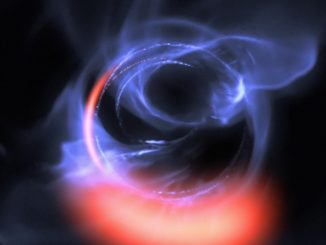
South Africa’s newly inaugurated 64-dish MeerKAT radio telescope, a precursor to the Square Kilometre Array, has imaged the heart of the Milky Way in unprecedented detail, revealing long, magnetised filaments and the blazing core where a supermassive black hole lurks unseen at optical wavelengths.
“We wanted to show the science capabilities of this new instrument,” said Fernando Camilo, chief scientist at the South African Radio Astronomy Observatory. “The centre of the galaxy was an obvious target: unique, visually striking and full of unexplained phenomena, but also notoriously hard to image using radio telescopes. Although it’s early days with MeerKAT, and a lot remains to be optimised, we decided to go for it – and were stunned by the results.”
Built by the SARAO and inaugurated 13 July by Deputy President David Mabuza, MeerKAT’s 64 dishes eventually will be part of the Square Kilometre Array, the world’s largest radio telescope with hundreds of distributed dishes in Australia and South Africa. As it stands, MeerKAT’s dishes provide 2,000 unique antenna pairs, “resulting in high-fidelity images of the radio sky,” the SARAO said in a news release.
Earth’s Sun orbits the galaxy’s core at a distance of some 25,000 light years. While intervening gas and dust shroud the hidden heart of the galaxy where a super-massive black hole is known to reside, radio waves pass through to provide a glimpse of its hidden features. MeerKAT’s initial observations provide a tantalising hint of things to come.
Of special interest are long magnetised filaments discovered in the 1980s that are seen near the central black hole and nowhere else. Their origin is a mystery.
“The MeerKAT image has such clarity,” marvelled Farhad Yusef-Zadeh of Northwestern University in the United States, an expert on the filamentary structures seen near the central black hole. “The image shows so many features never before seen, including compact sources associated with some of the filaments, that it could provide the key to cracking the code and solve this three-decade riddle.”



